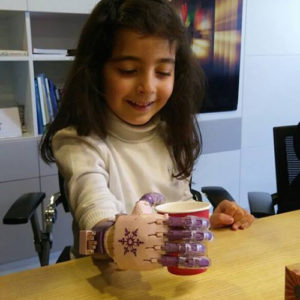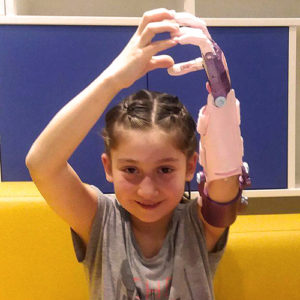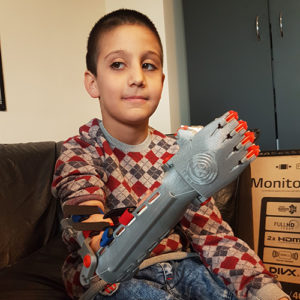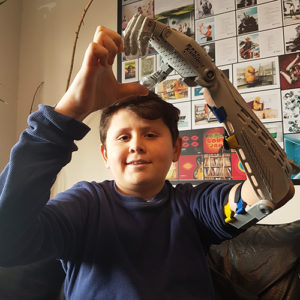Colorful 3D Printed Prosthetics for Kids: Taking A Closer Look at e-NABLE’s Robotel Türkiye Chapter in Istanbul
 This winter, we learned the heartwarming origin story of the e-NABLE Turkey chapter, also known as Robotel Türkiye, from volunteer Zeynep Karagöz, originally with Istanbul-based design team 5 dakika. Karagöz first contacted the e-NABLE volunteer organization in 2014, in hopes of volunteering the design team’s 3D printing skills to make 3D printed prosthetics for kids in need, and also showing the Turkish community the many advantages of the technology. After helping volunteer Mehmet Ali Toprak get his own e-NABLE prosthetic hand, the chapter was officially born. Robotel Türkiye realized the power of social media, and started a Facebook page, which hit over 1,000 likes in one week; in January, that number was up to nearly 3,900, and today, the page has over 5,400 likes.
This winter, we learned the heartwarming origin story of the e-NABLE Turkey chapter, also known as Robotel Türkiye, from volunteer Zeynep Karagöz, originally with Istanbul-based design team 5 dakika. Karagöz first contacted the e-NABLE volunteer organization in 2014, in hopes of volunteering the design team’s 3D printing skills to make 3D printed prosthetics for kids in need, and also showing the Turkish community the many advantages of the technology. After helping volunteer Mehmet Ali Toprak get his own e-NABLE prosthetic hand, the chapter was officially born. Robotel Türkiye realized the power of social media, and started a Facebook page, which hit over 1,000 likes in one week; in January, that number was up to nearly 3,900, and today, the page has over 5,400 likes.
 In addition to serving as the Turkish chapter of the e-NABLE volunteer organization, Robotel Türkiye itself is a design agency that operates out of Istanbul, and has been using 3D printing technology for several agency projects since 2008. In 2017, it became an official NGO, under the name Robotel Derneği, and is currently working to expand the project by meeting with corporations and other civil organizations in hopes of setting up new collaborations.
In addition to serving as the Turkish chapter of the e-NABLE volunteer organization, Robotel Türkiye itself is a design agency that operates out of Istanbul, and has been using 3D printing technology for several agency projects since 2008. In 2017, it became an official NGO, under the name Robotel Derneği, and is currently working to expand the project by meeting with corporations and other civil organizations in hopes of setting up new collaborations.
 The chapter is now up to over 1200 volunteers, with 47 registered volunteer provinces and 160 registered 3D printers. In addition to some specialized prosthetic instrument holder devices, Robotel Türkiye has over a dozen recommended prosthetic models, including Raptor and Raptor Reloaded and Flexy Hand and Flexy Hand 2. Robotel Türkiye has multiple video resources, offering help in everything from measuring a recipient’s hand to working in Meshmixer and taking recipient photos for e-NABLE. Volunteers meet regularly in Ankara, Istanbul, and İzmir to discuss and distribute cases, and to meet new volunteers. In addition, the organization organizes workshops and events to expand the volunteer network, create social awareness, and teach volunteers how the Robotel Türkiye process works:
The chapter is now up to over 1200 volunteers, with 47 registered volunteer provinces and 160 registered 3D printers. In addition to some specialized prosthetic instrument holder devices, Robotel Türkiye has over a dozen recommended prosthetic models, including Raptor and Raptor Reloaded and Flexy Hand and Flexy Hand 2. Robotel Türkiye has multiple video resources, offering help in everything from measuring a recipient’s hand to working in Meshmixer and taking recipient photos for e-NABLE. Volunteers meet regularly in Ankara, Istanbul, and İzmir to discuss and distribute cases, and to meet new volunteers. In addition, the organization organizes workshops and events to expand the volunteer network, create social awareness, and teach volunteers how the Robotel Türkiye process works:
- Coordination and Organization: coordinate the volunteer network
- Announcement: publicize the project and determine cases
- Documentation and Measurement: take measurements and photos of Robohand candidates
- Design: determine the optimal Robohand model and design modifications
- 3D Printing and Assembly: 3D print and assemble Robohand parts
- Delivery and Inspection: deliver and test the Robohand, make modifications if necessary
The goal of the organization is to provide people (mostly children) who suffer from finger and hand deformations with 3D printed prosthetics, in hopes of helping them integrate into society and making their daily lives easier. But the main target group that Robotel Türkiye focuses on is kids with developmental limb disorders stemming from ABS (Amniotic Band Syndrome).
According to Robotel Türkiye, “Children do not have access to prosthetics beacuse they develop very fast and they need to replace it constantly. Families and social security systems cannot afford this. Therefore, children do not get prosthetics until they are 18 and fully developed.
“Robotel Türkiye works with these children and their families together in order to help both physically and socially & emotionally in their daily life.”
These 3D printed prosthetics can help kids with daily tasks, like holding objects, swimming, and riding bikes; in addition, because they are 3D printed out of non-toxic, organic plastic and can come into contact with food, the prosthetics can also help kids eat.
However, most kids don’t like being thought of as different, and having a finger or hand disability, whether you were born with it or it occurred due to an accident later in life, definitely makes you different.
Karagöz told 3DPrint.com, “We are focusing on 3D design and 3D printing help these kids with their emotional and social state as well as their physical needs. So we are trying to design the hands with their favorite characters or colors.”
Robotel Türkiye has developed a plethora of fun 3D printed prosthetics, in hopes of easing the young recipients’ fears that different is wrong, or bad. Kids get to pick the colorful materials and design themes for their hands, which help provide social and emotional support as well as the ability to perform day-to-day tasks. Young Delfin received a pink prosthetic arm, with a Frozen theme and featuring Queen Elsa of Arendelle. In the above picture, Delfin is at her first breakfast with her new 3D printed prosthetic; Ece was also fitted with a custom Frozen prosthetic, featuring purple snowflakes. Robotel Türkiye prosthetic recipient Elif also has a pink arm, but the Robohand doesn’t feature any characters, just her favorite color.
- Ece Naz
- Elif Su
- Huseyin
- Yunus Emre
Huseyin received a Robohand with a Captain America theme, while Yunus adapted very quickly to using his The Fast and the Furious movie series-themed prosthetic arm. Robotel Türkiye has also made 3D printed prosthetics with Spiderman and cat themes, and even one featuring Turkish cartoon character Canım Kardeşim.
“With these hands we aim to increase the life standards of these children. By giving them a tool to facilitate their daily routines and proving them with a joyful design to make them feel like exceptional; we aim to touch as many lives and hearts as possible,” said Robotel Türkiye.
You can check out the volunteer chapter’s YouTube channel to see more stories of kids in need who received some of these cool prosthetic arms. I expect we will hear a lot more about the creative, kid-friendly 3D printed prosthetics from Robotel Türkiye in the future; for now, take a look at Karagöz’s TedX talk in Istanbul (please note, the video is not in English):
Subscribe to Our Email Newsletter
Stay up-to-date on all the latest news from the 3D printing industry and receive information and offers from third party vendors.
You May Also Like
New Report: Semiconductor Industry to See $1.4B in 3D Printing Revenues by 2032
“The semiconductor sector has become the most strategically significant area of global industry.” Truer words are hard to come by when it comes to the modern world, and they are...
Will Photonic-Crystal Lasers Revolutionize 3D Printing?
Powder bed fusion (PBF) for metals and polymers predominantly utilizes lasers as the primary heat source. Some directed energy deposition (DED) technologies also employ lasers, while various vat polymerization methods...
3D Printing Unpeeled: Orbex Investment, IndoMIM and HP, Ultrasonic Waves
INDO-MIM has bought three HP Metal Jet S100 printers, operating two in India and one in Texas. This is a win for HP because the company has deep experience in...
3D Printing Webinar and Event Roundup: April 21, 2024
It’s another busy week of webinars and events, starting with Hannover Messe in Germany and continuing with Metalcasting Congress, Chinaplas, TechBlick’s Innovation Festival, and more. Stratasys continues its advanced training...





































